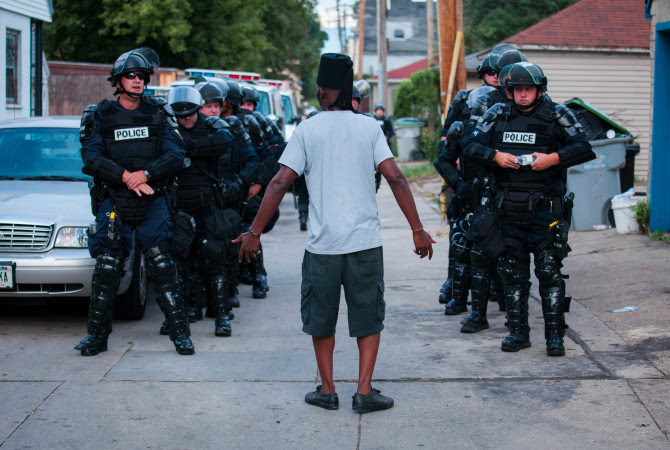By: Peniel E. Joseph

The third summer of our discontent is almost over.
The latest tensions started in Ferguson, Mo., two years ago; then came Baltimore last year, with Milwaukee the latest city to erupt in protests and upheaval as tensions continue to run high across the nation between law enforcement and black Americans living in some of the nation’s most racially segregated and poverty-stricken neighborhoods.
Just as before, the tensions were brought on by several recent police killings of blacks. Baltimore County police shot and killed 23-year-old Korryn Gaines in a confrontation at her home that injured her 5-year-old son. Officers used lethal force to execute an arrest warrant, actions that many are questioning as a needless provocation that we’ve seen too many times before. The fact that Gaines previously used social media to record her interactions with police and that she may have been suffering from emotional problems only exacerbates this latest tragedy.
In Los Angeles’ Compton neighborhood, Donnell Thompson, a mentally challenged black man, was killed by SWAT officers who mistakenly believed that he was a carjacker. The incident happened in late July, and authorities are only now admitting the case of mistaken identity. “I wouldn’t treat an animal this bad,” observed his sister as she mourned her brother’s senseless death.
The same day Thompson was killed in California, Chicago police chased down and killed Paul O’Neal, an 18-year-old suspected car thief. Police cameras show officers repeatedly shooting at the vehicle O’Neal was driving and handcuffing him as he lay in his own pool of blood.
The coroner’s finding that O’Neal had been shot in the back has led to widespread protest in Chicago, which has a horrific recent history of anti-black police shootings.
But the latest front in this ongoing racial battlefield is in Milwaukee, which erupted after police shot and killed a 23-year-old armed black man during a confrontation. Local residents staged protests—some of which turned violent—that railed against decades of civic neglect in some of the city’s poorest areas.
Just as in Ferguson and Baltimore, television images capturing racial violence on Milwaukee’s impoverished north side focused on burning cars, looted stores, and clashes between police and demonstrators while glossing over the high rates of poverty, unemployment and police abuse of local residents in which the violence is rooted.
Still, the focus in the media is on the symptoms of systemic racism—unrest and protest—and not the root cause igniting these fires. But not everyone is turning a blind eye to the blight, neglect and police-inflicted violence that plague these neighborhoods.
The Department of Justice’s recent report on racist police practices in Baltimore inadvertently explains Milwaukee’s uprising and serves as a warning that, without substantive political changes, other cities may explode. The Baltimore report reveals a brutally exploitative system of racial profiling, harassment and drug arrests that constitutes a virtual war against black residents waged by a Police Department that is 44 percent black.
“A Vision for Black Lives,” a radical policy agenda authored by a coalition of Black Lives Matter activists, represents a political and policy response to events happening in Milwaukee, Baltimore and elsewhere around the nation. The agenda calls for eliminating racial bias in prisons at the federal, state and local levels and redirecting federal resources from prison building and police task forces into community building; drug rehabilitation; mental-health facilities; and education, employment and environmental resources.
More important, the BLM policy agenda challenges all Americans to reimagine the relationship among citizens, governments and institutions. In short, it calls for a political revolution. Racial violence and dehumanization in America have become so routine that for every black body that receives national attention, there are many more whose deaths are rendered virtually invisible.
Changing this cycle requires taking funds used to militarize police departments and redistributing them to black communities in need of mental-health services, jobs, schools and drug-rehabilitation facilities. The philosophy of law and order has corrupted not only the criminal-justice system but also much of America’s political system. Assaults on black voting rights, chronic unemployment, deteriorating schools and neighborhoods, and the astonishing increase in the number of black women in city jails are all part of our ongoing national civil discourse that is rarely mentioned in public, but whose effects proliferate all around us.
The criminal-justice system represents a gateway to institutions, polices and practices that are undermining the life chances of black people at a generational level. As the Baltimore report shows, the real tragedy lies in acknowledging the black quotidian: the struggles of ordinary, everyday African-American communities to survive against a war-torn landscape where police act less as public servants and more as an occupying army for a war that’s been waged for decades but has yet to be publicly declared.
Peniel E. Joseph, a contributing editor at The Root, is professor and founding director, the Center for the Study of Race and Democracy, the Lyndon B. Johnson School of Public Affairs at the University of Texas at Austin. He is the author of Waiting ’Til the Midnight Hour: A Narrative History of Black Power in America, Dark Days, Bright Nights: From Black Power to Barack Obama and Stokely: A Life. Follow him on Twitter.














